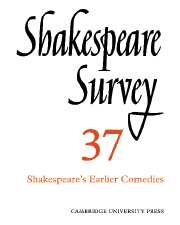Book contents
- Frontmatter
- Criticism of the Comedies up to The Merchant of Venice: 1953–82
- Plotting the Early Comedies: The Comedy of Errors, Love’s Labour’s Lost, The Two Gentlemen of Verona
- The Good Marriage of Katherine and Petruchio
- Shrewd and Kindly Farce
- Illustrations to A Midsummer Night’s Dream before 1920
- The Nature of Portia’s Victory: Turning to Men in The Merchant of Venice
- Nature’s Originals: Value in Shakespearian Pastoral
- 'Contrarieties agree': An Aspect of Dramatic Technique in Henry VI
- Falstaff’s Broken Voice
- ‘He who the sword of heaven will bear’: The Duke versus Angelo in Measure for Measure
- War and Sex in All’s Well That Ends Well
- Changing Places in Othello
- Prospero’s Lime Tree and the Pursuit of Vanitas
- Shakespearian Character Study to 1800
- How German is Shakespeare in Germany? Recent Trends in Criticism and Performance in West Germany
- Shakespeare Performances in Stratford upon–Avon–and London, 1982–3
- The Year's Contributions to Shakespearian Study 1 Critical Studies
- 2 Shakespeare’s Life, Times and Stage
- 3 Editions and Textual Studies
- Index
Falstaff’s Broken Voice
Published online by Cambridge University Press: 28 March 2007
- Frontmatter
- Criticism of the Comedies up to The Merchant of Venice: 1953–82
- Plotting the Early Comedies: The Comedy of Errors, Love’s Labour’s Lost, The Two Gentlemen of Verona
- The Good Marriage of Katherine and Petruchio
- Shrewd and Kindly Farce
- Illustrations to A Midsummer Night’s Dream before 1920
- The Nature of Portia’s Victory: Turning to Men in The Merchant of Venice
- Nature’s Originals: Value in Shakespearian Pastoral
- 'Contrarieties agree': An Aspect of Dramatic Technique in Henry VI
- Falstaff’s Broken Voice
- ‘He who the sword of heaven will bear’: The Duke versus Angelo in Measure for Measure
- War and Sex in All’s Well That Ends Well
- Changing Places in Othello
- Prospero’s Lime Tree and the Pursuit of Vanitas
- Shakespearian Character Study to 1800
- How German is Shakespeare in Germany? Recent Trends in Criticism and Performance in West Germany
- Shakespeare Performances in Stratford upon–Avon–and London, 1982–3
- The Year's Contributions to Shakespearian Study 1 Critical Studies
- 2 Shakespeare’s Life, Times and Stage
- 3 Editions and Textual Studies
- Index
Summary
When Charles Mathews the Elder first appeared as Falstaff at the Theatre Royal, Hay market, in 1814, a critic remarked: ‘What was wanting to make it a perfect representation was the round volume of voice commensurate with the hollow of the frame from which it came.’ As far as I know, no critic or scholar has considered this requirement unreasonable; yet it contradicts what the texts say about Falstaff’s voice. From both parts of Henry IV it seems clear that Falstaff was meant to speak not in deep, sonorous tones, but in a voice grown high and thin with advanced years - like the voice of Silence in the recent BBC television production, or the falsetto of William Hutt’s Shallow at Stratford, Ontario, in 1965.
Though the texts make Shakespeare’s conception clear beyond reasonable doubt, it is easy to see why it has been ignored. Our reading has been guided by our experience of stage Falstaffs, and audiences have expected a great voice answerable to the great body. At Drury Lane ‘Harper’s fat figure, full voice, round face, and honest laugh... fixed him at last in the jolly knight’s easy chair’; and Quin had a ‘happy swell of voice’.
- Type
- Chapter
- Information
- Shakespeare Survey , pp. 85 - 88Publisher: Cambridge University PressPrint publication year: 1984

